History of Christians in Nepal
In 1628, Portuguese Father Juan Cabral, during the reign of Laxmi Narsingha Malla, ruler of Kantipur, 1620-1641, entered Nepal. He had permission from the King of preach Christianity in Kathmandu valley. But basically, gospel was brought to Nepal by Nepalese who were outside Nepal, as they come in and go. It is said that United Mission to Nepal and INF, along with other Christians living in India, came to Nepal with other western missionaries.
Albert Orville from Belgium and Johann Grueber from Austria came to Nepal as missionary. However their works and services are unknown.
This is the old photo of Nepal when Christian Mission agencies try to enter Nepal from the souther border of India.
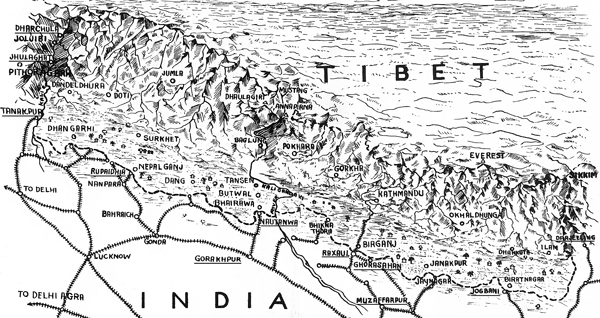
Capuchin fathers, from Vatican, arrived in Kathmandu on March 14, 1703 and stay until 1715. Father Tranquillius built a small Church in Wotu Tole in Kathmandu on March 24, 1760. Its name was The Assumption of Our Lady. They were expelled to India's Bettiah when first Shah King, Prithvi Narayan conquer three kingdom of Kathmandu valley, all, Capuchin fathers and 57 local Newari Christian converts were driven out of Nepal, ending nearly half decades Christian presence in Nepal.
In the year 1661, Pratap Malla, the then King of Kathmandu received Albert d’Orville and Johann Grueber – a Belgian and an Austrian with open arms into the valley. They were visiting Kathmandu from the imperial Chinese Observatory in Peking via Lhasa. He granted them permission to preach the new religion, but without waiting for permission for a permanent stay, they left for Agra, the headquarters of the Tibet-Hindustan Mission in India.
During the conquest of the three kingdoms of the valley by King Prithvi Narayan Shah (1744 – 1769), Jayaprakash Malla of Kathmandu sought the help of the East India Company in his fight against him. Suspicion fell on the Capuchins for having been involved in the scheme and it worsened after the invasion. This became untenable and thus on 4th Feburary 1769, they left the valley along with a small group of religious refugees and found their way to Bettiah, India.

First Nepali Bible translator, Ganga Prasad Pradhan, along with Scottish missionary in India, who were studying in Serampore University founded by William Carey, translated the Bible into Nepali language. Slowly, missionaries start to enter Nepal in 1950 but did not directly involve in preaching the gospel. They were focused on social services like, hospitals, education, and others. From just a single secret Christian residing in Nepal in 1951, the number of Nepali Christians grew to about 40,000 baptized believers by 1990 and has increased more rapidly since then. Nepal became officially Hindu state under King Mahendra, conversion was not illegal but proselytizing was illegal. Groups of Internationals Christian agency made United Mission to Nepal and founded Saint Xavier School in Godawari, Patan Hospital and Tansen Hospital which provided grade one services to the people of Nepal. It was after Nepal became democracy that many people accepted Jesus Christ as their personal Lord and savior. Christians in Nepal were overjoyed when Nepal was declared secular state in 2008. Christian population in Nepal outgrew to triple in 2011 from 2001, but this record is not entirely accurate. There are more numbers of istians then it is estimated. Some of the reason for this is during the census, new Christians were afraid to say they were Christian, so they wrote, Hindu.
The most comprehensive survey of Christians in Nepal was conducted by the Nepal Research and Resource Network. Begun in 2001 with the results published in 2007, the survey covered all seventy-five districts of the country. It showed a total of 2,799 churches, 274,462 baptized members, 379,042 persons attending, this number equals about 1.5 percent of Nepal’s population. Today, 2016, we estimate, there are above 2 millions Christians live in Nepal.
Darjeeling, on the eastern border of Nepal, was developed by the British, and a large community of Nepalis settled there to labor in the tea plantations. William MacFarlane, a Church of Scotland missionary, began the Eastern Himalayan Mission in 1870, a work active in education, Christian literature, Bible translation, and village evangelism. All were important foundations for the future as the Darjeeling and Kalimpong region became the main center for the nascent Nepali church.
Australian Nepalese Mission (ANM), Founding missionary John Coombe with his wife, Lillian, and two children in 1917 established a base in Ghorasahan, Bihar, their focus for three decades was on Nepal. They were typical of other missionaries and groups that, though seemingly insignificant, served faithfully in anticipation of Nepal’s border opening.
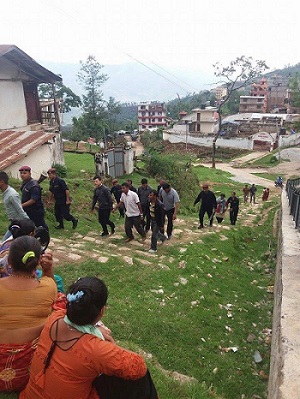
Regions Beyond Missionary Union (RBMU), along with the Raxaul Medical Mission, worked in Bihar in the late nineteenth century, but the missionaries’ eyes were fixed on Nepal. Duncan Hospital, established in 1930 by Dr. Cecil Duncan (son of a missionary in Darjeeling). The site was well chosen and Duncan Hospital subsequently played a vital role in the entry of both church and mission into Nepal.
Finally, mention must be made of Dr. Kitty Harbord, the Nepal Evangelistic Band (NEB) at Nautanwa, another railhead, and the Nepal Border Fellowship (NBF). Harbord, of the Zenana Bible and Medical Mission (later Bible and Medical Missionary Fellowship, and now Interserve), opened a dispensary at Nautanwa in 1927. She recruited Dr. Lily O’Hanlon and Hilda Steele, who in 1943 founded the Nepal Evangelistic Band (now the International Nepal Fellowship). NEB was later, in 1952, to pioneer the move into Pokhara. These societies planted the seeds for the movement of the growth of the Christianity in Nepal.
Key Nepali men and women became Christians during the “century of preparation.” One was Chandra Leela, the daughter of the Brahmin priest to the royal family in Kathmandu. Born in 1840, married at the age of seven, widowed at nine, and orphaned at fourteen, she became a sunyasi (Hindu holy woman) and for seventeen years searched the depths of Hinduism in her quest for solace and peace. Eventually she abandoned her quest but soon after met a young girl with a Bible. After reading the Bible she became a Christian and went back to Kathmandu to speak of her new faith. She baptized her older brother shortly before he died, but then returned to India as an itinerant evangelist until her death.
Sadhu Sundar Singh
Here is a history archieve of Indian Evangelist from Punjab who visited Nepal to preach the gospel. In between 1912- 1920, One day in Nepal, Sundar was ambushed by four robbers in the middle of a jungle. The exact time for this incident is not known. Sadhu Sundar Singh might have come to Nepal multiple times. Possibly 1914 and 1915. One of them brandished a sword. Meekly, Sundar bowed his head thinking that his life was about to end. This attitude surprised the perpetrators. Since he was penniless, they took his blanket away from him and let him go. But then, one of the robbers called him back and curiously asked his name. Sundar introduced himself, opened his Bible and started telling him the story of the rich man and Lazarus the poor. The robber said that the end of the rich man's life was unpleasant and asked what would happen to him. Sundar then told him about the Gospel and God's forgiveness. The robber took Sundar home with him and repented.
In the town of Rasa, he was sentenced to death by a local Lama on the grounds of spreading a foreign religion. Somewhere in Nepal Tibet border, (citation needed), He was thrown into a dry well the top of which was then covered and locked from the outside. He was without food and drink, naked inside the well together with corpses of executed murderers. He stayed in the horrible well for 2 days until a stranger came and helped him out of the well. After relocking the well, the stranger left without saying anything. Not long after that, Sundar was recaptured and taken to the Lama. The Lama was very surprised since he had always kept the only key to the well with him. Realizing that Sundar was under the protection of a very powerful God, they became fearful of him and begged him to leave them.
Sadhu Sunder Singh came to Nepal in June 7, 1915. As he entered Nepal he started preaching in the district of Ilam to all kinds of people whom he met. Many people heard the Gospel and believed him and soon this was reported to the authorities and he was arrested and put into prison. Even in the prison he preached the Gospel to the prisoners. Authorities were afraid to hold him in Prison, in fear that he will convert more people to Christianity; they threaten him and sent him to Darjeeling, India.
It could be possible that, he was beaten and left half dead in the forest of Nepal. Secret Christians came to his rescue. Another time, when he sang of Christ in prison, he was bound in stocks and hurled into the jungle to die. Again secret Christians came at night and released him, speaking to him for long hours of the faith they shared. Men who knew him said he was more like Christ than any other man they had known.
Another early Christian was Ganga Prasad Pradhan, who was born into a wealthy Newar family in Kathmandu in 1851. When he was ten his father took him to Darjeeling to join his older brother in MacFarlane’s school, where Ganga Prasad was educated and converted, which led to a remarkable life of Christian service. He was “the first ordained Nepali pastor, translator of the Nepali Bible (completed in 1914 after forty years of labor—he was made a life governor of the British and Foreign Bible Society), pioneer in Nepali literature, and owner of the first Nepali press.” In 1914 Ganga Prasad returned with his extended family to Kathmandu to establish a Christian presence there, but they were expelled by the Rana rulers with the words, “There is no room for Christians in Nepal!” A great legacy of Ganga Prasad was a hymn he wrote that for fifty years expressed the expectant prayers of the waiting clusters of missionaries and exiled Nepali Christians—“Prabhu arji suni leu, Gorkhali le mukti paune dhoka kholi deu . . .”
Forty-three years after Ganga Prasad had been expelled; his great-grandson Rajendra Rongong, Robert Karthak, and a small group of Darjeeling Christians entered Kathmandu with a strong sense of missionary calling instilled by RBMU missionary Elisabeth Franklin. And forty years later, in 1997, Rajendra Rongong and Robert Karthak were the key persons to lead one of the earliest Nepali missionary teams into Myanmar, where they helped establish the Myanmar Gurkhali Christian Fellowship.
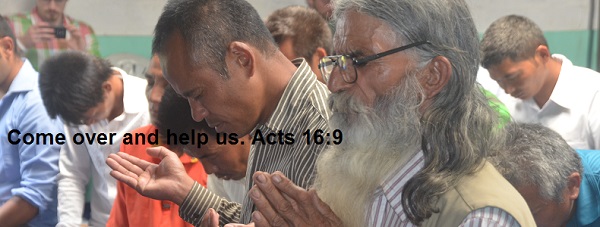
Buddhi Singh, a humble watchmaker from eastern Nepal who was converted in Darjeeling by Ganga Prasad, was for many years an itinerant village evangelist with the Gorkha Mission, an indigenous Nepali mission founded by Darjeeling Christians in 1892 to evangelize Nepalis. In his later years he influenced the young David Mukhia, who in 1952 became the first pastor in Nepal, at the Ram Ghat Church in Pokhara.
Colonel Nararaj Shamsher Jung Bahadur Rana was a member of the Rana aristocracy who retired from the army and lived in the Terai region, not far from Raxaul. He visited Duncan Hospital with his sick grandson, met Ernest Oliver (then field leader of RBMU but later a founder of the United Mission to Nepal and its first executive secretary), and became Nicodemus, a secret believer. The Colonel Sahib (as he was known) was baptized by Oliver on Easter Sunday, 1952, and was instrumental in hosting the first church services in Kathmandu in his home there in April 1953. He was also a major contributor to the revised translation of the entire Nepali Bible, published by the Bible Society in 1977.
(In Photo) Prem Pradhan, alone was put into prison 14 times for baptizing and telling others about Jesus between 1960-1975. He dead in 1998.)
Since 1970, Christianity in Nepal has been growing faster per capita than anywhere else—not only South Central Asia, but in the world. Christianity is growing in Nepal at nearly 11 percent per year. From just 7,400 in 1970 to more than 1 million today, the projected number of Christians by 2020 is 1,324,000.
Born into a Hindu family, Pradhan served as a Gurkha warrior in the British Air Force until a gun wound left him with a lifelong limp. In 1951, he encountered an Indian street evangelist and trusted Christ. At the evangelist’s recommendation he read the New Testament six times, eventually becoming a full-time evangelist himself.
Pradhan was imprisoned 14 times in Nepal between 1960 and 1975 for openly
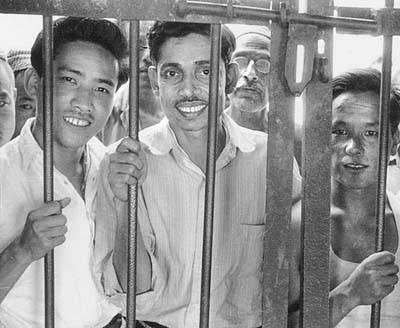
baptizing Hindu converts. While in jail he preached Christ to his cellmates and jailors, and saw dozens come to faith. He never wavered in his call to evangelism.
Prem Pradhan (center), along with Bir Bahadur Rai (left) and Dil Bahadur Thakuri (right) held in Tansen prison for their Christian faith (1961).
Pradhan died on November 15, 1998, and is buried in Sarlai, Nepal.
The First Generation (1951–90)
When King Tribhuvan opened Nepal’s borders in 1951, he invited the world to assist in Nepal’s development. It was then, by almost any criteria, one of the world’s poorest countries—and it still is. Three distinct groups converged to contribute to the formation of the church in Nepal.
Chronologically, the first group consisted of foreign Christians entering from India, beginning with Father Moran, a Jesuit priest working in Patna, Bihar, who established St. Xavier’s School on the edge of the Kathmandu valley in July 1951. In 1952 the Nepal Evangelistic Band in Nautanwa was given permission to establish medical work in Pokhara, and in October Dr. O’Hanlon and Hilda Steele, with four expatriate colleagues and five Nepali Christians, including David and Premi Mukhia, trekked for nine days from Nautanwa to reach Pokhara. The “Shining Hospital” soon became renowned, and the mission later developed into the International Nepal Fellowship (INF). Its work continues to be primarily medical, but it has spread and diversified through many parts of western Nepal.
Formation of the United Mission to Nepal (UMN) came about through several remarkable coincidences. During the 1951 revolution, fighting took place just over the border from Raxaul, and wounded combatants from both sides were treated at Duncan Hospital. As a result of this service, after the revolution Dr. Trevor Strong and Ernest Oliver were invited by His Majesty’s Government of Nepal (HMGN) to visit Kathmandu to explore the possibility of mission work. They were told that medical and educational work would be welcome, but open preaching would be prohibited. These discussions dovetailed with a separate approach made by authorities in Tansen, a large hill-town west of Kathmandu and halfway between Nautanwa and Pokhara, to American missionaries Bob and Bethel Fleming (Methodist) and Carl and Betty Friedericks (Presbyterian). Contact had been
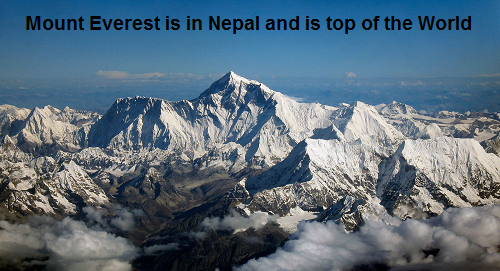
made earlier as a result of ornithological trips into Nepal in October 1949 and in the winter of 1951–52, during which medical assistance had been given to the people of Tansen. Eventually, permission was granted to open a hospital in Tansen and clinics in Kathmandu.
Lindell rightly refers to the foundation of the UMN as “some of the finest missionary statesmanship that has been exercised in the modern missionary movement.” Influential Methodist bishop J. Wascom Pickett circulated HMGN’s letter of invitation to other missions in conjunction with the National Christian Council (NCC) of India, with a view to “establishing a Christian mission in Nepal on the widest possible cooperative basis, a combined interdenominational and international approach.” The NCC endorsed Pickett’s proposal, and the United Christian Mission to Nepal was founded in Nagpur in March 1954.
There were eight founding missions; Pickett became the founding president of the board and Ernest Oliver the first executive secretary. The Flemings had already commenced medical work in Kathmandu in January 1954, and the Friederickses began work in Tansen in June 1954, but the work quickly expanded and diversified to include education, engineering, and rural development. The activities of the UMN were defined and reviewed in a series of five-year agreements with Nepal’s government. There have always been clear prohibitions on proselytizing, but the Christian nature of the UMN and the personal faith of its workers are known and accepted. “The Mission takes the terms seriously . . . and has learned that its stay in Nepal rests on a mixture of invitation, permission and mutual agreement; that it is temporary . . . [and] that it is in partnership with Nepali society.” At the time of the 1990 revolution, the UMN comprised 39 member missions, 420 expatriate missionaries, and over 2,000 Nepali staff.

Nepal’s first church was formed at Ram Ghat, Pokhara, in 1952 with David Mukhia as pastor. Others followed in the Kathmandu valley. Tir Bahadur became the pastor at Bhaktapur in 1954. Rongong and Karthak’s small group that arrived from Darjeeling in 1956 appointed Robert Karthak as pastor the following year. This group developed into the Nepali Isai Mandali, commonly known as Gyaneshwar Church, which today is the largest congregation in Nepal. Other Darjeeling Christians became an integral part of the work of the UMN in remote projects and were instrumental in establishing small congregations that have continued. Many have grown into substantial churches, and several have multiplied.
A third, smaller group consisted of four Christians from the Mar Thoma Church in Kerala, South India, who arrived early in 1953. They were led by C. K. Athyali, whose mother had been so challenged at the Kerala Marama convention in the 1920s by Sadhu Sundar Singh’s accounts of his trips through Nepal to Tibet that she dedicated her unborn child to be a missionary to Nepal. The group joined with the Colonel Sahib, who hosted worship services in his house in central Kathmandu. Later, he helped them purchase land in Putali Sadak, close to the parliament buildings, on which Kathmandu’s first church building was constructed. Over the years many Christians from Kerala have given exemplary, lifelong service to Nepal, especially in the fields of education and medicine.
During this early phase (1951–61) numerical growth was gradual, but three important features should be noted. First, Nepal’s constitution and legal code prohibited conversion to another religion. The flow of converts was only a trickle during these early years and only a few baptisms took place. Second, although the NEB and the UMN were not engaged in church planting and were not officially linked to any of the churches, a symbiotic relationship between the churches and the missions did exist with mutual benefit and encouragement as the church was being established. Third, the independence of the churches from the missions was fully evident: the leadership was entirely Nepali, the churches were self-funding, and there were no denominations. Each congregation was autonomous.
Two important events marked the end of the first decade: the outbreak of state persecution and formation of the Nepal Christian Fellowship. The first official persecution by the state took place following baptisms in Nepalgunj (1958) and Tansen (1959) by Pastor David and in 1960 by Pastor Prem Pradhan. In November 1960 Prem Pradhan and six baptized believers (three married couples) were imprisoned in Tansen, and the Supreme Court convicted them a year later: the women were sentenced for six months, the men for twelve months. Prem Pradhan was sentenced for six years (though he was released by royal pardon after four and a half years). Pastor David was included in the conviction, but he escaped across the border to Nautanwa and returned only in 1969. Sporadic arrests, which became the pattern for the next two decades, occurred elsewhere.
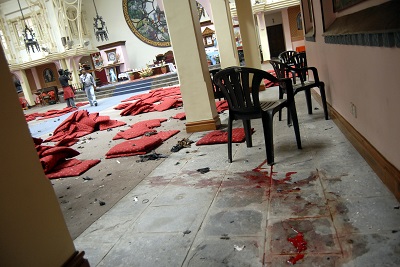
Government restrictions ensured that church and mission remained officially distinct and that evangelistic activity was done only by Nepalese.
Although the congregations were independent of the missions, the initiative of Ernest Oliver resulted in formation of the Nepal Christian Fellowship (NCF) in 1960, something that he regarded as “the most significant event in the first ten years of the church.” Pastor David from Pokhara was appointed president, and during his time in Nautanwa the NCF met there in 1962 and 1963. In 1966 Robert Karthak was appointed president; thereafter the NCF met biannually in Nepal and was “the means of bringing the autonomous young churches together for fellowship and mutual encouragement. . . . This was an effective means of uniting almost all of the [Protestant] Christians in the country until the late 1970s.”
For the church’s first ten years (1951–61), there was not much growth in numbers, but a strong foundation was laid. During the 1960s churches were established in key areas and wherever mission groups were working, even though government restrictions ensured that church and mission would remain officially distinct, that evangelistic activity would be done only by itinerant Nepali evangelists, and that the churches would remain nondenominational though they were united in fellowship and purpose.
Freedom and Expansion (1990 to the Present)
The dramatic events of the first half of 1990 marked a watershed both in the history of Nepal and in the growth of the Nepali church. The bloody Democracy Revolution in February/March 1990 culminated on April 6 with King Birendra’s announcement of a return to multiparty democratic government. A year passed before general elections were held and six months more before the new constitution was promulgated, but a new atmosphere of freedom and hope replaced the repression of the previous three decades.
It took months for the country to recover from the post revolution upheaval. At that time there were about 60 Christians in jail, and 200 cases against Christians were pending in the courts. The general amnesty granted by King Birendra on June 2, 1990, heralded a new era of freedom for Christians and the church. Still, though Section 19 of the 1990 constitution gave every religious community the right “to maintain its independent existence . . . and to manage and protect its religious sites and trusts,” Christian organizations experienced difficulty obtaining official recognition and registration. And although “freedom to profess and practice [one’s] own religion” was acknowledged, prohibition of conversion continued, with penalties of three to six years in jail specified by the Civil Code. Nevertheless, churches found ways of owning land and buildings, and public worship was open and without threat, although individuals continued to face persecution at personal and social levels, and sporadic cases of state persecution continued through the 1990s.
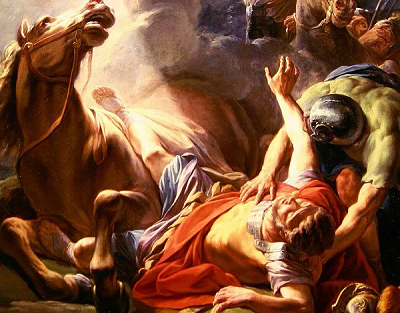
Following 1996 Nepal’s attempts to establish democracy were destabilized by the activities of the Maoist “People’s War.” The massacre of King Birendra and his family in June 2001 stunned Nepal and the world and gave rise to suspicions of treason within the country. After the February 2005 sacking of the government by King Gyanendra, political upheaval led to further unrest and instability until peace talks, brokered by the United Nations, led to an interim government that included the Maoists. The general election in April 2008 resulted in a Maoist-dominated coalition government with P. K. Dahal, popularly known as Comrade Prachanda, as prime minister. On May 28, 2008, Nepal’s Constituent Assembly, in a virtually unanimous vote, abolished the monarchy, establishing a federal democratic republic, and on July 23 Ram Baran Yadav was sworn in as the country’s first president.
At present Christianity is recognized publicly in many ways, a change foreshadowed by inclusion of “Christian” as an option in the religion category of the 1991 census. Christians regularly hold public meetings and processions at Christmas and Easter, to which senior politicians and dignitaries are invited. Ramesh Khatry states that during the People’s War “the government had the Maoists to deal with full time, thus the church grew unhampered,” and now with the change to democracy Christians have “boldness to make their demands known to the government. . . . Political instability remains despite the elections held in 2008, but Nepal has been declared a secular state and freedom of religion is now guaranteed.”
The Nepali church continues to grow outside Nepal as well. The Nepali Diaspora spread in Malaysia, Myanmar, Korea, UAE, Qatar, Saudi Arabia, Israel, Lebanon, USA, India has larger number of converts and Church growth outside Nepal.
Factors Contributing to Growth
Parallels between the first generation of the Christian church—which grew rapidly despite being situated within a hostile Roman Empire—and the first generation of the church in Nepal are apparent and have been explored elsewhere. From just a single believer residing in the country in 1950, the number of Christians in Nepal has grown, by a conservative estimate, to 2 percent of the population.

Several factors present during the three decades 1960–90 helped to form the character of the Nepali church and contributed to its growth and spread. First, there was an unprecedented degree of cooperation among various Christian groups.
Second, House to house visit and Gospel Crusade, Susamachar Dhawa led many to open their spiritual eyes.
Third, the prohibition of conversion and the reality of persecution from the outset prevented nominalism and kept the church strong.
Fourth, most converts were young, vigorous, and vibrant, with a keen sense of evangelistic outreach to the majority society. Also, family conversions were not uncommon, and mass conversions occasionally took place among tribal groups.
Fifth, retired Gurkha servicemen who had converted to Christianity while in the Indian or British army returned to their villages and established small Christian communities.
Sixth, new Christians were trained in Bible Colleges in different parts of India and Nepal. When they were graduated all of them made Nepal their ministry place.
Seventh, several parachurch groups, especially student and youth organizations, worked alongside the churches to spur evangelism and to support new Christians. Such as YWAM, OM, CCFC, YFC, CEF gave boost to the growth.
Eighth, Christian literature, Radio, Correspondence course, TV, Christian Magazines spread the Christian message provided the guidance to the new converts.
Ninth, the Nepali songbook brought together various earlier collections of indigenous songs. The predominant use of indigenous songs and tunes reflected the general pattern of indigenous worship that included such culturally appropriate practices as meeting on Saturdays and gender-segregated seating on the floor, often in ordinary village homes.
Perhaps the most significant factor, and certainly the single most recurring theme in the short history of the Nepali church, is the place of prayer. Gordon words of prayer: “Prayer can penetrate anywhere. Long before we enter the valleys
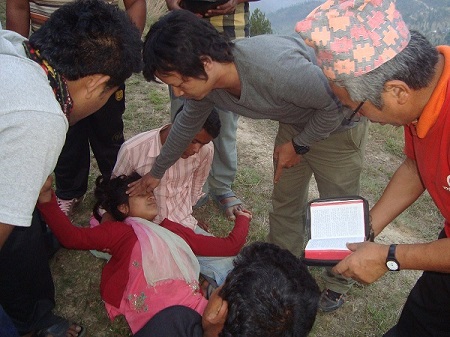
of Nepal prayer can be doing a concrete work in laying the foundations for the future kingdom. . . . When we have prepared the way with the Spirit of God in prayer, he will answer those very prayers in permitting us to occupy Nepal.” Ganga Prasad’s prayer-song and the Darjeeling Nepali Christians who prayed for their closed land for decades; the NEB prayer groups across Britain spawned by Kitty Harbord’s enthusiasm; John Coombe’s prayer group in Fitzroy, the NBF (and later NPF), which prayed for decades in anticipation of Nepal’s borders opening; Ernest Oliver and Trevor Strong praying as they overlooked the Kathmandu valley in April 1951, Elizabeth Franklin, who prayed for twenty-three years before entering Nepal; and the Kerala mother who, like Hannah, prayed for a son and then dedicated him to be a missionary in Nepal. Ganga Prasad’s prayer song, “Prabhu arji suni leu, Gorkhali le mukti paune dhoka kholi deu . . .” The list is too extensive to record, and it continues to grow today.
Less than forty years after Ganga Prasad was told in 1914, “There is no room for Christians in Nepal,” the Rana regime was ousted by the Shah dynasty. Today, less than 100 years after Ganga Prasad was turned out of the country, King Gyanendra has abdicated and the Shah dynasty itself has been abolished, but the church is firmly established and growing in Nepal.
Famous for its high peaks and wind-whipped prayer flags, Hindu-majority Nepal used to be a nation unreached by Christianity.
Now the country has one of the fastest-growing Christian populations in the world, according to the World Christian Database, which tracks global trends in Christianity.
Bishwa Mani Pokharel, news chief at Nepal's Nagarik newspaper, pulls out copies of the census to show the statistical gallop of Christianity across Nepal. It listed no Christians in 1951 and just 458 in 1961. By 2001, there were nearly 102,000. A decade later that number had more than tripled to more than 375,000.
"Before, when the Christians had a party, they slaughtered a chicken. Now, they slaughter a goat," says Pokharel, who has been reporting on the conversions. That extra meat, he explains, is necessary to feed all of the new people who've joined the guest list.
Much of this growth can be attributed to Nepal's internal changes. Before 1950, Nepal was closed to foreigners.
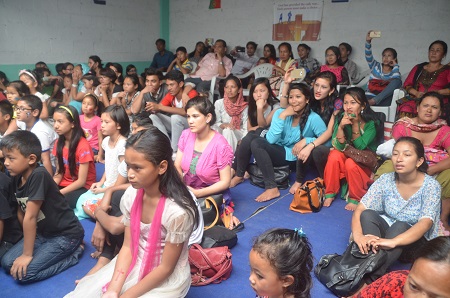
Mountain climbing changed that. And starting with the Maoist Civil War of the 1990s and culminating with the end of the monarchy in 2008, the country has transitioned from a Hindu kingdom to a communist-led secular republic with greater freedom of religion. Encouraging someone to convert to another religion was always illegal, but as Nepal eased away from its official Hindu status, the rules lightened up.
Churches now mushroom throughout the Kathmandu Valley and across the terraced hills. Proselytizing remains illegal, but with political instability and weak law enforcement, that doesn't stop it from happening.
Meanwhile, the earthquake last year may have strengthened the Christian surge. Where the government — long mired in political instability — has failed to help poor villagers, aid groups have trickled in to fill gaps, some of them carrying a message of salvation.
Others point to the Hindu caste system as an impetus. Though outlawed in 2001, caste discrimination is still widely practiced, particularly in rural Nepal, where people on the lower rungs suffer systematic abuse passed on between generations. Many converts come from these lower castes, and missionaries point to Christianity as a way to escape. It's the only way out. Socially there's nothing they can do to change that and then we come along and we share about Jesus and the love he has for them. The system still exists, but no longer has power over them.
End
NOTES

 First Nepali Bible translator, Ganga Prasad Pradhan, along with Scottish missionary in India, who were studying in Serampore University founded by William Carey, translated the Bible into Nepali language. Slowly, missionaries start to enter Nepal in 1950 but did not directly involve in preaching the gospel. They were focused on social services like, hospitals, education, and others. From just a single secret Christian residing in Nepal in 1951, the number of Nepali Christians grew to about 40,000 baptized believers by 1990 and has increased more rapidly since then. Nepal became officially Hindu state under King Mahendra, conversion was not illegal but proselytizing was illegal. Groups of Internationals Christian agency made United Mission to Nepal and founded Saint Xavier School in Godawari, Patan Hospital and Tansen Hospital which provided grade one services to the people of Nepal. It was after Nepal became democracy that many people accepted Jesus Christ as their personal Lord and savior. Christians in Nepal were overjoyed when Nepal was declared secular state in 2008. Christian population in Nepal outgrew to triple in 2011 from 2001, but this record is not entirely accurate. There are more numbers of istians then it is estimated. Some of the reason for this is during the census, new Christians were afraid to say they were Christian, so they wrote, Hindu.
First Nepali Bible translator, Ganga Prasad Pradhan, along with Scottish missionary in India, who were studying in Serampore University founded by William Carey, translated the Bible into Nepali language. Slowly, missionaries start to enter Nepal in 1950 but did not directly involve in preaching the gospel. They were focused on social services like, hospitals, education, and others. From just a single secret Christian residing in Nepal in 1951, the number of Nepali Christians grew to about 40,000 baptized believers by 1990 and has increased more rapidly since then. Nepal became officially Hindu state under King Mahendra, conversion was not illegal but proselytizing was illegal. Groups of Internationals Christian agency made United Mission to Nepal and founded Saint Xavier School in Godawari, Patan Hospital and Tansen Hospital which provided grade one services to the people of Nepal. It was after Nepal became democracy that many people accepted Jesus Christ as their personal Lord and savior. Christians in Nepal were overjoyed when Nepal was declared secular state in 2008. Christian population in Nepal outgrew to triple in 2011 from 2001, but this record is not entirely accurate. There are more numbers of istians then it is estimated. Some of the reason for this is during the census, new Christians were afraid to say they were Christian, so they wrote, Hindu.

 baptizing Hindu converts. While in jail he preached Christ to his cellmates and jailors, and saw dozens come to faith. He never wavered in his call to evangelism.
baptizing Hindu converts. While in jail he preached Christ to his cellmates and jailors, and saw dozens come to faith. He never wavered in his call to evangelism. made earlier as a result of ornithological trips into Nepal in October 1949 and in the winter of 1951–52, during which medical assistance had been given to the people of Tansen. Eventually, permission was granted to open a hospital in Tansen and clinics in Kathmandu.
made earlier as a result of ornithological trips into Nepal in October 1949 and in the winter of 1951–52, during which medical assistance had been given to the people of Tansen. Eventually, permission was granted to open a hospital in Tansen and clinics in Kathmandu. Nepal’s first church was formed at Ram Ghat, Pokhara, in 1952 with David Mukhia as pastor. Others followed in the Kathmandu valley. Tir Bahadur became the pastor at Bhaktapur in 1954. Rongong and Karthak’s small group that arrived from Darjeeling in 1956 appointed Robert Karthak as pastor the following year. This group developed into the Nepali Isai Mandali, commonly known as Gyaneshwar Church, which today is the largest congregation in Nepal. Other Darjeeling Christians became an integral part of the work of the UMN in remote projects and were instrumental in establishing small congregations that have continued. Many have grown into substantial churches, and several have multiplied.
Nepal’s first church was formed at Ram Ghat, Pokhara, in 1952 with David Mukhia as pastor. Others followed in the Kathmandu valley. Tir Bahadur became the pastor at Bhaktapur in 1954. Rongong and Karthak’s small group that arrived from Darjeeling in 1956 appointed Robert Karthak as pastor the following year. This group developed into the Nepali Isai Mandali, commonly known as Gyaneshwar Church, which today is the largest congregation in Nepal. Other Darjeeling Christians became an integral part of the work of the UMN in remote projects and were instrumental in establishing small congregations that have continued. Many have grown into substantial churches, and several have multiplied.
 Following 1996 Nepal’s attempts to establish democracy were destabilized by the activities of the Maoist “People’s War.” The massacre of King Birendra and his family in June 2001 stunned Nepal and the world and gave rise to suspicions of treason within the country. After the February 2005 sacking of the government by King Gyanendra, political upheaval led to further unrest and instability until peace talks, brokered by the United Nations, led to an interim government that included the Maoists. The general election in April 2008 resulted in a Maoist-dominated coalition government with P. K. Dahal, popularly known as Comrade Prachanda, as prime minister. On May 28, 2008, Nepal’s Constituent Assembly, in a virtually unanimous vote, abolished the monarchy, establishing a federal democratic republic, and on July 23 Ram Baran Yadav was sworn in as the country’s first president.
Following 1996 Nepal’s attempts to establish democracy were destabilized by the activities of the Maoist “People’s War.” The massacre of King Birendra and his family in June 2001 stunned Nepal and the world and gave rise to suspicions of treason within the country. After the February 2005 sacking of the government by King Gyanendra, political upheaval led to further unrest and instability until peace talks, brokered by the United Nations, led to an interim government that included the Maoists. The general election in April 2008 resulted in a Maoist-dominated coalition government with P. K. Dahal, popularly known as Comrade Prachanda, as prime minister. On May 28, 2008, Nepal’s Constituent Assembly, in a virtually unanimous vote, abolished the monarchy, establishing a federal democratic republic, and on July 23 Ram Baran Yadav was sworn in as the country’s first president.
 of Nepal prayer can be doing a concrete work in laying the foundations for the future kingdom. . . . When we have prepared the way with the Spirit of God in prayer, he will answer those very prayers in permitting us to occupy Nepal.” Ganga Prasad’s prayer-song and the Darjeeling Nepali Christians who prayed for their closed land for decades; the NEB prayer groups across Britain spawned by Kitty Harbord’s enthusiasm; John Coombe’s prayer group in Fitzroy, the NBF (and later NPF), which prayed for decades in anticipation of Nepal’s borders opening; Ernest Oliver and Trevor Strong praying as they overlooked the Kathmandu valley in April 1951, Elizabeth Franklin, who prayed for twenty-three years before entering Nepal; and the Kerala mother who, like Hannah, prayed for a son and then dedicated him to be a missionary in Nepal. Ganga Prasad’s prayer song, “Prabhu arji suni leu, Gorkhali le mukti paune dhoka kholi deu . . .” The list is too extensive to record, and it continues to grow today.
of Nepal prayer can be doing a concrete work in laying the foundations for the future kingdom. . . . When we have prepared the way with the Spirit of God in prayer, he will answer those very prayers in permitting us to occupy Nepal.” Ganga Prasad’s prayer-song and the Darjeeling Nepali Christians who prayed for their closed land for decades; the NEB prayer groups across Britain spawned by Kitty Harbord’s enthusiasm; John Coombe’s prayer group in Fitzroy, the NBF (and later NPF), which prayed for decades in anticipation of Nepal’s borders opening; Ernest Oliver and Trevor Strong praying as they overlooked the Kathmandu valley in April 1951, Elizabeth Franklin, who prayed for twenty-three years before entering Nepal; and the Kerala mother who, like Hannah, prayed for a son and then dedicated him to be a missionary in Nepal. Ganga Prasad’s prayer song, “Prabhu arji suni leu, Gorkhali le mukti paune dhoka kholi deu . . .” The list is too extensive to record, and it continues to grow today. Mountain climbing changed that. And starting with the Maoist Civil War of the 1990s and culminating with the end of the monarchy in 2008, the country has transitioned from a Hindu kingdom to a communist-led secular republic with greater freedom of religion. Encouraging someone to convert to another religion was always illegal, but as Nepal eased away from its official Hindu status, the rules lightened up.
Mountain climbing changed that. And starting with the Maoist Civil War of the 1990s and culminating with the end of the monarchy in 2008, the country has transitioned from a Hindu kingdom to a communist-led secular republic with greater freedom of religion. Encouraging someone to convert to another religion was always illegal, but as Nepal eased away from its official Hindu status, the rules lightened up.